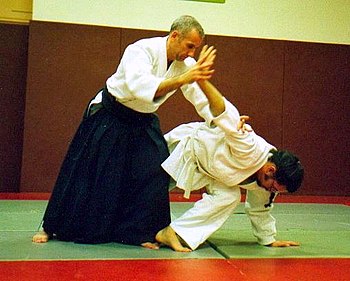 |
| Aikido: nikyo omote (second principle) (Photo credit: Wikipedia) |
Aikido is often viewed as more of a defensive martial art since its techniques and teachings are designed for you to avoid or get out of trouble. On the contrary, Aikido's techniques are very powerful and effective.
Basically, there are four levels of technique in Aikido training. These are the katai which refers to the basic training and is intended to build the foundation of body movements and breathing; the yawarakai trains the defendant to deflect attacks and fuse movements to take control of the attacker or situation; the ki-no-nagare which involves training the defendant to defend or counter attack by merging his movement with the attacker even before the latter makes contact; and the ki which is the absolute Aikido technique and involves establishing a link of ki or spirit from the defender to the attacker.
When training for Aikido, you need a sparring partner. The uke and the nage. The Uke is the initiator of the attack and receives the Aikido techniques, while the Nage is the defender and the one that neutralizes the attack.
Aikido basic techniques include ikky which involves control an attacker by placing one hand on the elbow and one on near the wrist giving an opportunity to throw the attacker to the ground; the niky which draws in the uke using a wristlock and twists the arm while applying painful nerve pressure; sanky which is a rotating technique aimed at applying a spiralling tension on the whole arm including the elbow and shoulder; yonky a shoulder control technique with both hands gripping the forearm; goky is another variant of ikky
wherein the hand gripping the wrist is inverted and is quite useful in weapon take-aways; shihnage or the four-direction throw; kotegaeshi or wrist return which involves a wristlock-throw that stretches the extensor digitorum; kokynage also known as breath throws or timing throws; iriminage or entering-body throws which resembles a "clothesline" technique; tenchinage or heaven-and-earth throw; koshinage or the Aikido's version of the hip throw; jinage or the shaped-like-'ten'-throw; and kaitennage or rotation throw wherein the nage sweeps the arm of the uke back until it locks the shoulder joint after which the nage applies forward pressure to throw the attacker.
These are just basic techniques and from the list, thousands of possible implementations or combinations can be drawn by the aikidokas. In Aikido, the strikes employed during the implementation of the Aikido technique are called atemi. For beginners, grabs are the first ones to be taught. It is safer and the aikidoka can easily feel the energy flowing from the uke to the nage.
Among the basic grab techniques are the katate-dori or single-hand-grab which involves using one hand to grab one wrist; morote-dori or both-hands-grab which uses both hands to grab one wrist; ryte-dori another both-hands-grab technique wherein both hands are used to grab both wrists; kata-dori or the shoulder-grab technique; and the mune-dori or chest-grab which involves grabbing the clothing of the chest of the attacker.
Mastering each technique involves discipline and dedication. To be a good aikodoka, one must master both the techniques and principle of martial art.



